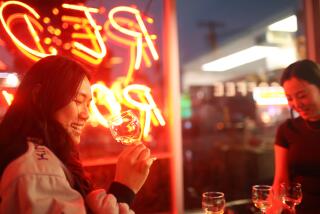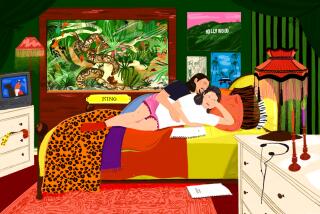A Setting Sun for Icehouses
- Share via
SAN ANTONIO — It’s a poor man’s community center, a latter-day trading post or a Tejano juke joint. It’s a scruffy backdrop for birthday parties, stump speeches and domino showdowns. Not quite a bar, but more than a convenience store, the icehouse is the sleepy, shadowy soul of the working-class neighborhoods of South Texas.
Since icehouses sprouted from the steamy streets of Texas’ burgeoning cities in the first half of the last century, they have been all of these things, and something else. Comfortable turf for lawyers or factory workers, bikers and children. Places to cool down, show off or swap salacious tales.
But in a modern landscape of television, shopping malls and singles bars, icehouses are melting away, one by one.
“It’s a dying breed,” says manager Cathy Doria, running fingers over the counter at Stanley’s Ice Station #2, a fading stack of cinder blocks on San Antonio’s south side. Catching sight of a regular, she interrupts herself.
“How ya doin’, Tony?” her voice booms over the hiss and drone of college football. “Bob beatcha in and beatcha out. He quit smokin’, so it doesn’t take him so long to drink.” She gives him a hard stare. “You gonna be a good boy today, Tony?”
Outside, the sun is setting into the sunken bowl of the city. A chill stands in the concrete shadows by the take-away window -- another autumn is stretching into winter. In the scrubby wash of cypress and mesquite that is Stanley’s backyard, barefoot girls spin and scramble at a tetherball stalk. An old-timer grips his Budweiser, claps a fedora onto his head and shuffles over the yellowing grass to a bench in the sun. College kids slouch at the rims of the pool tables. They are here in common, the young and the old and the in-between.
An icehouse can be as simple as an overgrown hot dog stand, or can be crammed into a converted shed, an abandoned garage or a nondescript storehouse. They are dim buildings where hot weather is battled with creaking ceiling fans and rollaway garage doors -- a little dirty and a little sweaty, the sort of place where neighborhood mutts, blue jeans and horseshoes are right at home.
“They’re sloppy, slapdash, added onto,” San Antonio architect Henry Munoz says. “It’s this informal architecture where the canopy records the time of day, where the garage door lets the inside out. Some people think they’re tacky. I think they’re beautiful.”
Icehouses sell beer and soda pop, along with jumbles of fishing supplies, canned chili and lottery tickets. They stop shy of selling hard liquor, but might offer glasses of coke or tonic for those who carry flasks. Most rigid of all criteria -- and any discerning icehouse enthusiast will underline this point emphatically -- it isn’t an icehouse if it doesn’t sell sacks of ice.
“It’s an ungraspable thing,” says Tom Denyer, a former Texas A&M; professor who has studied the history and sociology of icehouses. “They’re folk art -- performance art done by folk without being concerned about audience or reaction. You go into an icehouse and it’s human drama.”
There used to be an icehouse for just about every neighborhood in South Texas. In theory, they were places to pick up ice. In practice, they were one of the region’s defining social institutions. There was an icehouse near St. Mary’s University where young Chicano intellectuals argued late into the night over poetry and Central American intervention. There were icehouses where Democrats knew they’d better put in a campaign appearance; icehouses known for their conjunto music; icehouses renowned for their menudo and barbecue.
The neighborhood lore of Flores Street is preserved in the chatter of Stanley’s cashiers: The day they refused to sell another beer to a tipsy preacher and he condemned them to hell. The time Ernie got a little drunk, crawled atop a creaking table and commenced an unsteady striptease. Remember the night Mando had to be carried home?
Stanley’s has the jumbled look of a tag sale gone to seed. “Pride Not Prejudice,” reads a sign behind the bar. There is a lewd Spanish proposition for Osama bin Laden and plastic beads that the owner’s grandchildren strung into necklaces, flats of motor oil and a procession of slot machines. Painted vignettes of penguins and palm trees cling to the facade.
B.B. Taylor’s father haunted the pool table here when she was a kid. She grew up to work behind the bar. “I remember,” she says from her perch at the counter, “he’d be here drinking and shooting pool.”
It wasn’t as if somebody one day invented the icehouse. They evolved in the alley of time between the advent of ice plants and the innovation of air conditioning. Back then, everything moved slower in the long, thick summers, and scouting for shade qualified as a serious endeavor.
Back then, ice was precious. It hadn’t been long since the cold stuff was slashed from the northern glaciers and shipped south to Galveston. Then came the factories, and ice was carted in great steaming blocks to neighborhood distribution sheds to be sawed, chipped and sold.
Texas was changing fast in the decades of the world wars -- a petrochemical boom was reinventing the old ranch and farm state into a constellation of modern cities. Displaced country folk left their moribund hometowns and poured into the fledgling Texas metropolis to make a living. They gathered in icehouses to ease their homesickness and cool their summer sweats.
It began with ice, and grew. After a time, enterprising owners took to stocking milk, bread and cigarettes. Then they started icing down bottles of Coke and beer, and hauled benches out under the shade trees.
The icehouse was born.
“A guy could say, ‘I’m going to the icehouse and get some bread,’ ” says Mike Stanush, who owns Stanley’s. “But then he could stay for an ice cold beer.”
Icehouse patrons are a fiercely loyal set. People still drive back to the streets where they grew up, to the old sheds and garages where their parents whiled away the heavy, golden afternoons of bygone Julys. It was Stanush’s grandmother who first took him by the hand and led him into an icehouse. “She’d come and say, ‘We’re going honky-tonking,’ and we’d go with her and her boyfriend,” he says. “They’d drink a few beers, and we’d play pinball.”
Munoz too remembers the long afternoons leaning over a Big Red at his father’s side in the neighborhood icehouse. The men drank beer; their voices braided into a grown-up slur of politics. “That’s part of what I call the gentility of South Texas that’s dwindling, but not gone,” he says. “Things are slower; things are informal. There’s a social connection here that doesn’t exist in most big cities anymore.”
Nobody really knows why the icehouse flourished in South Texas. Was it the climatic combination of hot summer and dry prairie that encouraged outdoor lounging? Was it the influence of Catholics, who tended to regard alcohol more tolerantly than their Protestant brethren? Was it some cultural alchemy wrought by the proximity to Mexico, or by the influx of German immigrants to the Hill Country?
For whatever reason, icehouses teemed on a tight patch of the map, a region roughly bounded by Houston, San Antonio and the Mexican border. In what Denley calls the “more white, more Anglo, more Baptist” northern counties, icehouses were a far lesser -- and these days long defunct -- phenomenon. Icehouses existed where whites and Latinos mixed, as beat writer Jack Kerouac noted when he stumbled upon a “mad gas station” during a dark drive south to the Rio Grande through San Antonio.
“Mexicans were standing around in the hot light of the overhead bulbs that were blackened by valley summerbugs, reaching down into a soft drink box and pulling out beer bottles and throwing money at the attendants,” he wrote. “Whole families lingered around doing this. We were already almost out of America and yet definitely in it and in the middle of where it’s maddest.”
Stanley’s has been promising its patrons “the coldest beer in town” since 1954. There used to be a chain of Stanley’s sprinkled throughout San Antonio -- these days, the joint on Flores is one of the few icehouses left.
“Oh, heavens, I can’t tell you how long I’ve been coming here,” says John Ramirez. The retired policeman plants his elbows on the countertop, cowboy hat tugged low over his brow. “It’s kinda hard to say why a person picks a particular place to do their drinking.”
Sorrowful owners say icehouses have become an outmoded convention. Air conditioning has driven Texas summer indoors, turning the season into a series of scoots over burned pavement, a time to cower in frigid rooms and battle off the head colds brought by incessant chill.
Besides, the idea of wandering to the corner for a bottle of milk is an anachronism. Neon-lit mini-markets shimmer like squat lighthouses along the freeways and suburban byways. Ironically, the 7-Eleven chain grew from a Dallas icehouse.
Drinking has changed too. Sipping alcohol in plain view of the neighbors and children has an outmoded smack. “People want to go to fancy nightclubs nowadays,” says Stanush.
On Flores Street, the men peddle hot turkey legs in the lengthening shadows. A few miles away, the old Spanish missions stand green and crumbling under the weight of centuries. Night is coming down.
In the television set at Stanley’s, Texas is up on Tulane, a Longhorn rushes and the man in overalls hollers, “Looky here!” The patrons flip through Doria’s wedding album; the bartenders discuss the coming holidays.
“Used to be there were icehouses all the way up and down Flores, but I guess they just phased out,” says bartender Robin Rubin. “I don’t know -- they just aren’t here anymore.”
More to Read
Sign up for The Wild
We’ll help you find the best places to hike, bike and run, as well as the perfect silent spots for meditation and yoga.
You may occasionally receive promotional content from the Los Angeles Times.






